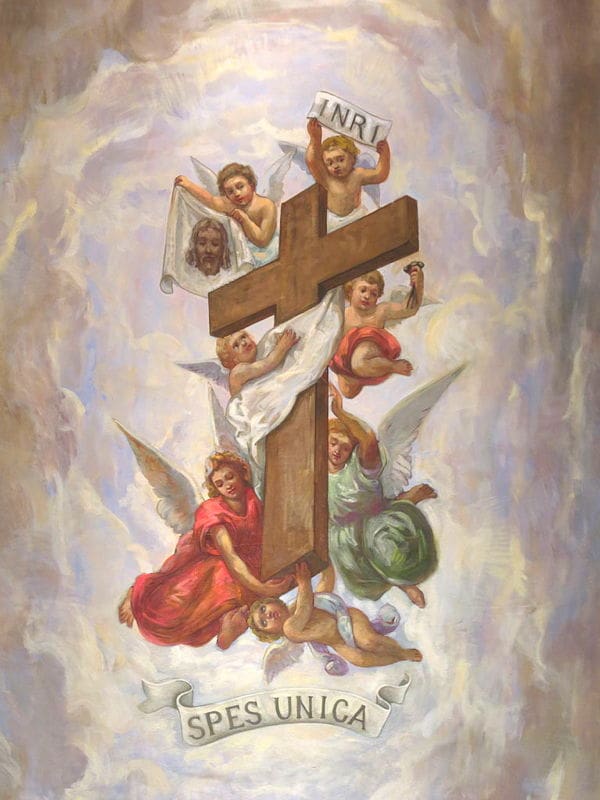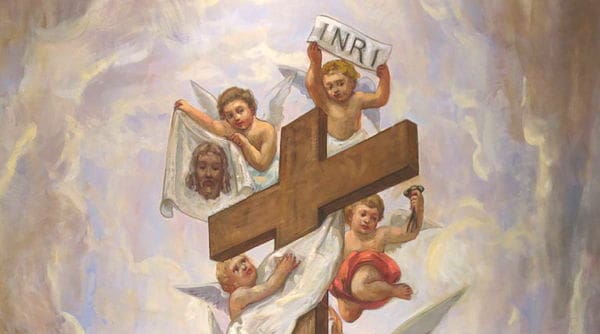LOVE OF THE CROSS
From a Meditation by St. Teresa Benedicta of the Cross
Feast of the Exaltation of the Holy Cross
“We hear repeatedly that St. John of the Cross desired nothing for himself but to suffer and be despised. We want to know the reason for this love of suffering. Is it merely the loving remembrance of the path of suffering of our Lord on earth, a tender impulse to be humanly close to him by a life resembling his? This does not seem to correspond to the lofty and strict spirituality of the mystical teacher. And in relation to the Man of Sorrows, it would almost seem that the victoriously enthroned king, the divine conqueror of sin, death, and hell is forgotten. Did not Christ lead captivity captive? Has he not transported us into a kingdom of light and called us to be happy children of our heavenly Father?
“The sight of the world in which we live, the need and misery, and an abyss of human malice, again and again dampens jubilation over the victory of light. The world is still deluged by mire, and still but a small flock has escaped from it to the highest mountain peaks. The battle between Christ and the Antichrist is not yet over. The followers of Christ have their place in this battle, and their chief weapon is the cross.
“What does this mean? The burden of the cross that Christ assumed is that of corrupted human nature, with all its consequences in sin and suffering to which fallen humanity is subject. The meaning of the way of the cross is to carry this burden out of the world. The restoration of freed humanity to the heart of the heavenly Father, taking on the status of a child, is the free gift of grace, of merciful love. But this may not occur at the expense of divine holiness and justice. The entire sum of human failures from the first Fall up to the Day of Judgment must be blotted out by a corresponding measure of expiation. The way of the cross is this expiation. The triple collapse under the burden of the cross corresponds to the triple fall of humanity: the first sin, the rejection of the Savior by his chosen people, the falling away of those who bear the name of Christian.

“The Savior is not alone on the way of the cross. Not only are there adversaries around him who oppress him, but also people who succor him. The archetype of followers of the cross for all time is the Mother of God. Typical of those who submit to the suffering inflicted on them and experience his blessing by bearing it is Simon of Cyrene. Representative of those who love him and yearn to serve the Lord is Veronica. Everyone who, in the course of time, has borne an onerous destiny in remembrance of the suffering Savior, or who has freely taken up works of expiation, has by doing so canceled some of the mighty load of human sin and has helped the Lord carry his burden. Or rather, Christ the head effects expiation in these members of his Mystical Body who put themselves, body and soul, at his disposal for carrying out his work of salvation. We can assume that the prospect of the faithful who would follow him on his way of the cross strengthened the Savior during his night on the Mount of Olives. And the strength of these cross-bearers helps him after each of his falls. The righteous under the Old Covenant accompany him on the stretch of the way from the first to the second collapse. The disciples, both men and women, who surrounded him during his earthly life, assist him on the second stretch. The lovers of the cross, whom he has awakened and will always continue to awaken anew in the changeable history of the struggling church, these are his allies at the end of time. We, too, are called for that purpose.
“Thus, when someone desires to suffer, it is not merely a pious reminder of the suffering of the Lord. Voluntary expiatory suffering is what truly and really unites one to the Lord intimately. When it arises, it comes from an already existing relationship with Christ. For, by nature, a person flees from suffering. And the mania for suffering caused by a perverse lust for pain differs completely from the desire to suffer in expiation. Such lust is not a spiritual striving, but a sensory longing, no better than other sensory desires, in fact worse, because it is contrary to nature. Only someone whose spiritual eyes have been opened to the supernatural correlations of worldly events can desire suffering in expiation, and this is only possible for people in whom the spirit of Christ dwells, who as members [limbs] are given life by the Head, receive his power, his meaning, and his direction. Conversely, works of expiation bind one closer to Christ, as every community that works together on one task becomes more and more closely knit and as the limbs of a body, working together organically, continually become more strongly one.
“But because being one with Christ is our sanctity, and progressively becoming one with him our happiness on earth, the love of the cross in no way contradicts being a joyful child of God. Helping Christ carry his cross fills one with a strong and pure joy, and those who may and can do so, the builders of God’s kingdom, are the most authentic children of God. And so those who have a predilection for the way of the cross by no means deny that Good Friday is past and that the work of salvation has been accomplished. Only those who are saved, only children of grace, can, in fact, be bearers of Christ’s cross. Only in union with the divine Head does human suffering take on expiatory power. To suffer and to be happy although suffering, to have one’s feet on the earth, to walk on the dirty and rough paths of this earth and yet to be enthroned with Christ at the Father’s right hand, to laugh and cry with the children of this world and ceaselessly to sing the praises of God with the choirs of angels this is the life of the Christian until the morning of eternity breaks forth.”
+
This meditation on the “Love of the Cross” is copyright by ICS Publications. Permission is hereby granted for any non-commercial use, if this copyright notice is included. Maintained by the Austrian Province of the Teresian Carmel.
+
Art for the post “Love of the Cross”: Basilica of the Sacred Heart (Notre Dame, Indiana) – interior, The Lady Chapel, mural, The Exaltation of the Holy Cross, detail of the Holy Cross, Luigi Gregori, photographed by Nheyob, 9 May 2013, CCA-SA 3.0 Unported, Wikimedia Commons. The term “Spes Unica“, seen in the painting, means “[Our] only hope” in Latin.





